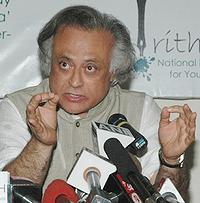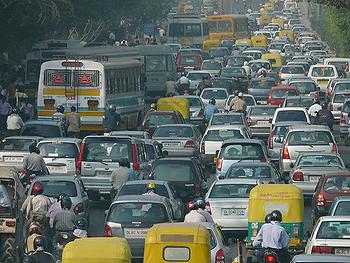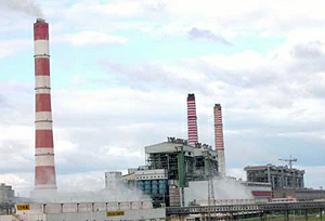India Pledges to Reduce Carbon Intensity
NEW DELHI, India, December 4, 2009 (ENS) - India will never accept legally binding emission cuts at Copenhagen, Environment Minister Jairam Ramesh told Parliament Thursday, but he did say the government plans to reduce India's level of "emission intensity" by 20 to 25 percent compared with 2005 levels.
Emission intensity is the ratio of greenhouse gas emissions to Gross Domestic Product. This statement marks the first time that India has offered to meet any type of numeric goal in the fight against global warming.
The announcement comes just days before the UN climate summit in Copenhagen, where governments are negotiating to limit greenhouse gases in the period after 2012 when the Kyoto Protocol's first commitment period comes to an end.
The Planning Commission, has on the basis of historical experience, concluded that a 20-25 percent reduction in emission intensity between 2005 and 2020 is possible, said the minister.
 |
India's Environment Minister Jairam Ramesh December 4, 2009 (Photo courtesy Government of India) |
Ramesh said the decision to reduce carbon intensity is essential for India to stake a claim to global leadership on climate change and take the moral high ground. "India could have chosen not to do anything and remained like the proverbial frog in the well, but the world would have laughed at India," Ramesh said.
Ramesh said that India will stick to two non-negotiables. "Besides no legally binding emission cut, the other non-negotiable is not to accept an agreement specifying a peak year - the year after which developing countries' emissions levels must peak and begin to decline.
He said India will not subject its indigenous technology, developed without foreign financial support, to any international emissions scrutiny, but added that the government will be flexible and willing to accept scrutiny of ventures developed with outside financial and technological support.
"India will accept a low carbon growth economy, which is essential for our livelihood plans," he said. "We are prepared to do even more, if a fair deal can be reached in Copenhagen. This is our baseline. We will do this on our own."
Ramesh said it is important to show those Indian people residing in low-lying areas vulnerable to rising sea levels and severe storms and those living in the midst of melting glaciers that the government is taking action to protect them from climate change.
 |
Traffic jam in Delhi, India (Photo by GJ Lingaraj) |
"More than to the international community, we have to show the action to our own people - to those living in the Sunderbans, in the north-east, in the Himalayas and in the Andaman and Nicobar islands – that the government was serious about tacking climate change," said the minister.
To accomplish its emissions reduction goals, Ramesh said the government would ask Parliament for a law that mandates fuel efficiency for all vehicles by December 2010.
He will propose other laws for an annual assessment of the increase in forest cover, an energy conserving Green Building Code and clean coal technology for India's coal-fired power plants.
Ramesh said the Indian team traveling to Copenhagen will include four Members of Parliament. Two school children and two college age students are part of the official team to convey India’s seriousness in doing something for future generations.
"By 2030, ‘40 or ‘50, you and I will not be alive," said the minister. "Those who will face the consequences of climate change are best suited to articulate these concerns."
 |
The coal-fired Vindhyachal power plant in Madhya Pradesh is India's largest power plant. (Photo courtesy Sarkaritel.com) |
The Indian offer to reduce its carbon intensity "will certainly help the negotiations process and is something India should be doing for external and, more importantly, for internal reasons," says Rajendra Pachauri, chairman of the scientific Intergovernmental Panel on Climate Change, IPCC. Dr. Pachauri, who hails from India, said the Indian government's action increases pressure on developed countries to do more to reduce their own greenhouse gas emissions.
Indian companies are way ahead in the region in disclosing their carbon emissions and setting performance targets for mitigation of greenhouse gas emissions, WWF India said Thursday.
Some 150 senior leaders from Indian business and industry came together to release the Carbon Disclosure Project Report 2009 – India 200. It documents the carbon dioxide emissions of the top 200 companies in India based on market capitalization.
Ravi Singh, secretary general and CEO, WWF-India said, "In the last three years, we have seen a significant improvement in quality and comprehension of companies to responses indicating integration of climate concerns in their decision making. It is important that the Indian industry is seen participating in this initiative given the imperatives of climate change and globalization."
British High Commissioner to India, Sir Richard Stagg said, "I'm pleased, and hugely impressed, at the way Indian companies are seeing the benefits of measuring and managing their carbon emissions."
"On the eve of Copenhagen, it's worth remembering that this is not a politically-driven decision. Rather, hard-headed and far-sighted businessmen are recognising that making money in the medium term will mean making a transition to a low-carbon model," said Stagg, adding, "as Indian business so often does, they're getting ahead of the pack. This can only be good for Indian business and for our shared, low carbon future."
Copyright Environment News Service (ENS) 2009. All rights reserved.
To subscribe or visit go to: http://www.ens-newswire.com